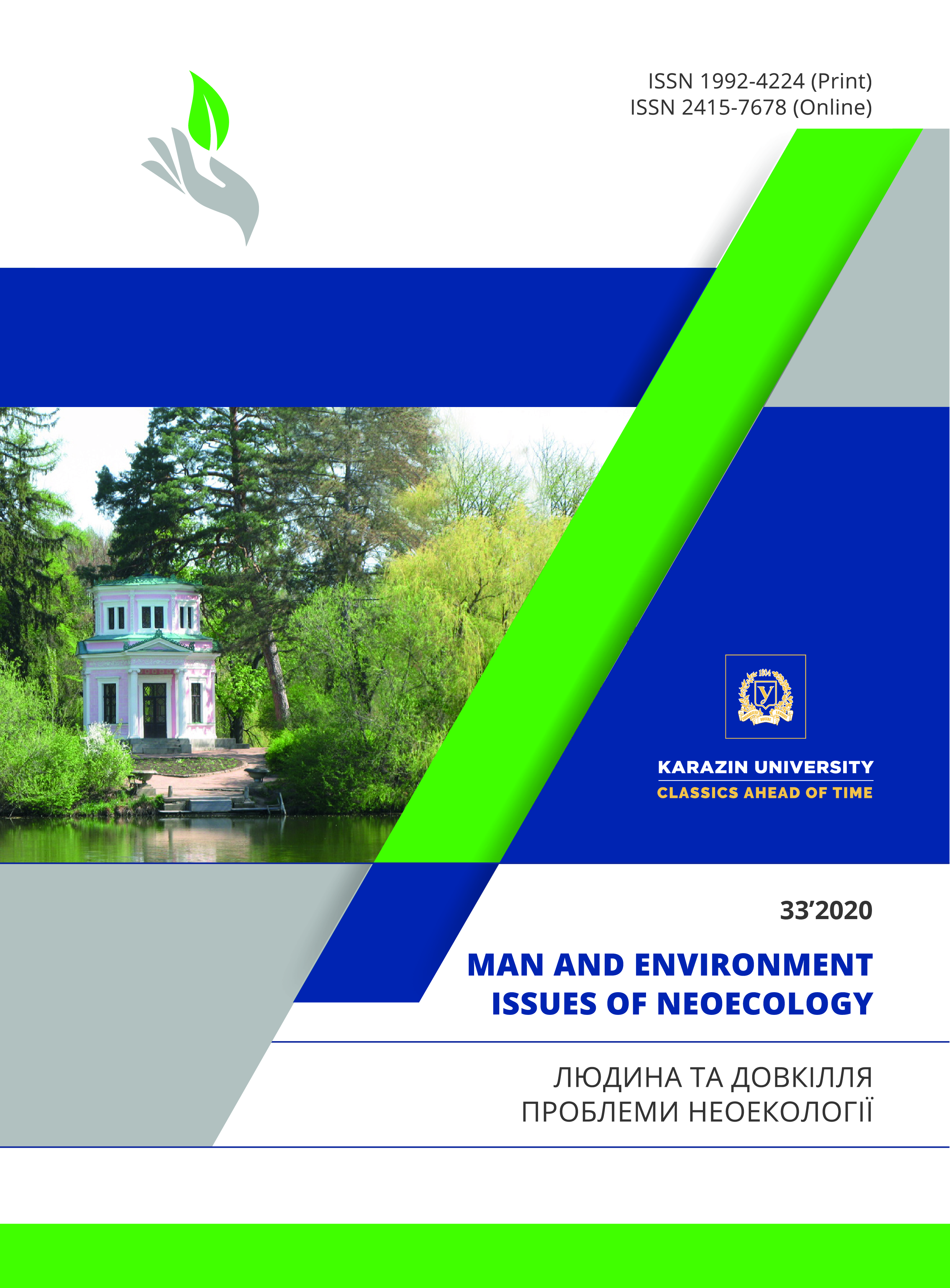Biondication of Anthropogenic Load on Agrobiodiversity in the Northern Azov Region of Ukraine
Abstract
Purpose. Determination of informative value of types of bioindicators from a number hunting animals for the estimation of the ecological state of agricultural landscapes and level of transformation in them of biological variety.Methods. The field (noise tuning-up, rout); ecological-analytical, statistical, methods of matrix algebra.
Results. It is set that in the conditions of Northern Azov region of Ukraine by key anthropogenic factors that determine the quantity of population : for a partridge grey is a structure of agricultural landscapes; for the European hare-hare - structure of sowing areas, quantity of predators and state of sunny activity. Considerable cross-correlation connection is first set between the quantity of populations of indicatory kinds and pesticide loading on territory as on regional, so on local levels. In the dynamics of populations of indicatory kinds found out the short and long waves of quantity. In the conditions of the pesticide pressure the most vulnerable is regulative influence of zoophages on consumers of more subzero orders. Therefore at megascopic pesticide loading regulative influence of predators will diminish on the row of representatives of phytophages, that explains the phenomenon of increase of quantity of some phytophages at general toxic impact from pesticides.
Conclusions. A high closeness of population and thick infrastructural network are the substantial factors of transformation of biovariety within the limits of region. The general of biological variety in a region as very tense. The ecological ground of potential kinds-indicators allows on the basis of investigational conformities to law the dynamics of their populations of different level of spatial organization to offer the method of bioindication of ecological violations in agricultural landscapes. Thus the informing index of anthropogenic pressure is a current quantity of population of indicatory type of the field fowl.
Downloads
References
Sozinov, O. O. & Pridatko, V. I. (2005). Agrobiodiversity of Ukraine: theory, methodology, indicators, examples. Book 1. Кyiv: Nichlava (in Ukranian).
Fedyushko, M. P. (2015). Agrobiodiversity as a component of nature management in the Northern Priazov region of Ukraine. Bulletin of Dnipropetrovsk State Agrarian and Economic University, (2), 20 - 24. Retrieved from http://ojs.dsau.dp.ua/index.php/vestnik/article/view/599 (in Ukranian).
Fedyushko, M. P. (2015). Ecological substantiation of indicator species of associated agrobiodiversity of the Northern Priazovye of Ukraine. Bulletin of Agrarian Science of the Black Sea Coast, 1 (82), 121-129. Retrieved from http://nbuv.gov.ua/UJRN/vanp_2015_1_16 (in Ukranian).
Fedyushko, M. P. Gorbatenko, A. A. & Hryb, O. G. (2011). Indicators of the state of associated agrobiodiversity. Scientific reports of NULES, 5 (27), 14 р. Retrieved from http://nd.nubip.edu.ua/2011_5/11fmp.pdf (in Ukranian).
Fedyushko, M. P. (2012). Bioindicators of ecological condition of agrolandscapes in the conditions of the Northern Azov region. Proceedings of the III International Conference: Modern problems of biology, ecology and chemistry, Zaporizhzhia, 2012, May 11-13 (p. 436-437). Zaporizhzhia, Copy Art (in Ukranian).
Fedyushko, M. P. (2015). Problems of greening of the agro-industrial complex of Ukraine. Scientific Bulletin of the National University of Life and Environmental Sciences of Ukraine, 214, 314-318. Retrieved from http://nbuv.gov.ua/UJRN/nvnau_biol_2015_214_49 (in Ukranian).
Bouman, A. F., Kram, T. & Goldewijk, K. (2006). Integrated modelling of global environmental change. An overview of MAGE 2.4. Retrieved from www.iiasa.ac.at/Admin/PUB/.../IR-08-020.p.
Alkemade, R., Oorschot, M., Miles L., Nellemann, Ch., Bakkenes M. & Ben ten Brink. (2009). GLOBIO3: A Framework to Investigate Options for Reducing Global Terrestrial Biodiversity Loss. Ecosystems, 12, 374 – 390. Retrieved from https://link.springer.com/article/10.1007/s10021-009-9229-5
The International Biodiversity Project. (2008). The Netherlands: The Netherlands Environmental Assessment Agency (MNP).
Prydatko, V., Kolomytsev, G., Burda, R. & Chumachenko S. (2008). Landscape Ecology: Textbook On Application Of Pressure-Based Biodiversity Modelling For National And Regional Educational Purposes. Kyiv: NAU.
Kazartseva, S. N. (2006). Ornithofauna of agricultural landscapes and its ecological features in modern con-ditions of nature management: on the example of the Voronezh region. (Master’s thesis). K.D. Glinka Voronezh State Agrarian University. https://www.dissercat.com/content/ornitofauna-selskokhozyaistvennykh-landshaftov-i-ee-ekologicheskie-osobennosti-v-sovremennyk (in Russian).
Hijmans, R.J., Cameron, S.E., Parra, J.L., Jones, P.G. & Jarvis A. (2005). Very high resolution interpolated climate surfaces for global land areas. International Journal of Climatology, 25, 1965-1978.
IPCC. (2007). Fourth assessment report: synthesis. Retrieved from http://www.ipcc.ch/pdf/assessment-report/ar4/syr/ar4_syr.pdf
Van Rooij, W. (2008). Manual for biodiversity modelling on a national scale. Retrieved from
https://unstats.un.org/unsd/envaccounting/seeaRev/meeting2013/EG13-BG-8.pdf
Alkemade, R., Bakkenes, M., Bobbink, R., Miles, L., Nellemann, C., Simons, H. & Tekelenburg, T. (2006). GLOBIO 3: Framework for the assessment of global terrestrial biodiversity. In A.F. Bouwman, T. Kramand, K. Klein Goldewijk, (Eds.). Integrated modelling of global environmental change. An overview of IMAGE 2.4. Netherlands Environmental Assessment Agency (MNP), Bilthoven, The Netherlands. 171–186.
Haitun, S. D. (2005). Quantitative analysis of social phenomena. Problems and prospects. Moscow: KomKniga (in Russian).
Popper, K. (1983). Logic and the growth of scientific knowledge. Moscow: Progress (in Russian).
Authors reserve the right of attribution for the submitted manuscript, while transferring to the Journal the right to publish the article under the Creative Commons Attribution License 4.0 International (CC BY 4.0). This license allows free distribution of the published work under the condition of proper attribution of the original authors and the initial publication source (i.e. the Journal)
Authors have the right to enter into separate agreements for additional non-exclusive distribution of the work in the form it was published in the Journal (such as publishing the article on the institutional website or as a part of a monograph), provided the original publication in this Journal is properly referenced
The Journal allows and encourages online publication of the manuscripts (such as on personal web pages), even when such a manuscript is still under editorial consideration, since it allows for a productive scientific discussion and better citation dynamics (see The Effect of Open Access).





